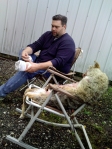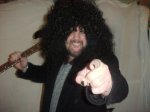After a number of overly exciting posts on the highs and lows of screenwriting for this film, I thought I would take a post to put on one of my other hats that I wore for this production: my actor hat. It is a hat that I, like many others, have always wanted to wear. But, unlike others, as someone who also owns writer and producer hats, I am able to write myself into the script, and then make an executive decision to cast myself in that role. While it may sound like self-nepotism (because of my many jobs) or egotism, the fact is I had reservations over playing the part that I wrote for myself, reservations that I’m sure Tyler shared.
My first reservation was my weight. When Tyler and I first began work on the project, I was pretty heavy. Without getting into numbers, let me just say that if the movie didn’t go forward, I could have been a contestant on The Biggest Loser. It was not good. My weight had fluctuated a lot over the years, but always managed to creep upward. So, I took my desire to handle a role in this film as motivation to really get my ass back on track and get some pounds off before production began. It was a job I took very seriously, and it became the catalyst for Tyler’s command that everyone get in better shape for the project, simple for health and endurance reason. This was going to be a tough shoot, which we were at least partially aware of, and we needed as cast and crew to be able to handle it. Being a small production, we’d not only be handling the demands of the script (see the next point), but also of the production, carrying equipment, building sets, holding positions for ungodly lengths of time.
I set about dieting and exercising 5-6 days a week, consistently actually missing maybe a week in two years (not counting shooting weeks). By the time we got to the production (what I call Grassman: Year One), I was down 45 lbs. When Grassman: Year Two ended, I had lost over 80 lbs. By, the end of Grassman: Year Three, I had quit smoking to top it all off. It was no easy task, but I’m glad I finally had this to push me in a direction I hadn’t passionately dedicated myself to for over 10 years. It felt good, and I felt good.
The second concern was the level of action in the film. Action and stunts are always a concern on films, but when you are an insane micro-budget action horror film without the common sense to know that you shouldn’t be doing what you are doing, it’s even more so. As the character of Catch, I had a significant amount my own stunts to perform. Aside from the requisite running through actual woods, I had to fight, jump, fall, take hits, and roll around, all while carrying a real, non-prop 14″ Smith & Wesson Search & Rescue Bowie Knife. Like I said, no common sense.
My major concern was my back. I have chronic back pain due to an US Army Airborne training accident when I was 19. I have a bulging disc, an only partially healed compressed vertebrae, and a touch of arthritis. The slightest thing can set it off and leave me essentially immobile. I once collapsed in a ball of pain on a bike trail because the damn back decided that one more push of the pedal was too much to ask. Stupid thing. However, I was willing to do whatever I had to do to make my action scenes as effective as I could. To top things off, day one of shooting, I contused my heal to the point where I needed to wrap it up tightly at the beginning of every day of shooting and wear running shoes when my feet weren’t in the shot. It didn’t get back to normal until around December of Grassman: Year One.
The final reservation was over acting itself. I am not an actor, nor have I ever claimed to be. But, I’ve always felt that I could pull it off in the right part, and have wanted to take on that challenge since I was a kid. I’ve had small parts in Monkey Prod shorts in the past (aside from BADNESS where I played Vlad the Rocking Impaler from Hell, an over-the-top rock stereotype based loosely on myself).
However, I usually either wound up on the digital cutting room floor (aka, the Recycle Bin), didn’t have my face shown at all, or the project never saw the light of day. Not a terribly auspicious bunch of credits for an acting reel.
Needless to say, there was a level of anxiety on my part, some self-doubt over my ability to carry my own weight in the thespian department. Granted, we have a cast of primarily inexperience actors, but my role was a significant one, the third lead. I couldn’t let my performance be the one that stood out at amateur or, even worse, laughable.
To make my anxiety worse, I was so consumed with re-writes and my producer duties, I was often unable to prepare for scenes until right before we shot them. I tried squeezing in learning lines when I could, but I really was pushing it most days. Having seen much of my work in our rough cuts, I am relieved to say that my acting doesn’t make me want to go punch myself in the face. That’s a plus.
Taking on this project was a monumental undertaking, and most of the folks involved found themselves performing multiple duties for many hours. I was the only dumbass who had a choice to not take on one of my jobs, but I did it anyways. I guess the lesson here is that no matter what your part might be in making your film a reality, you’re going to have your doubts. Don’t let them stop you, but use them to motivate you. It also helps to check your sanity at the door. But, get your ass to do whatever you have to do to make shit happen and guess what? Shit will happen. It’s like magic. So endeth the lesson.


























